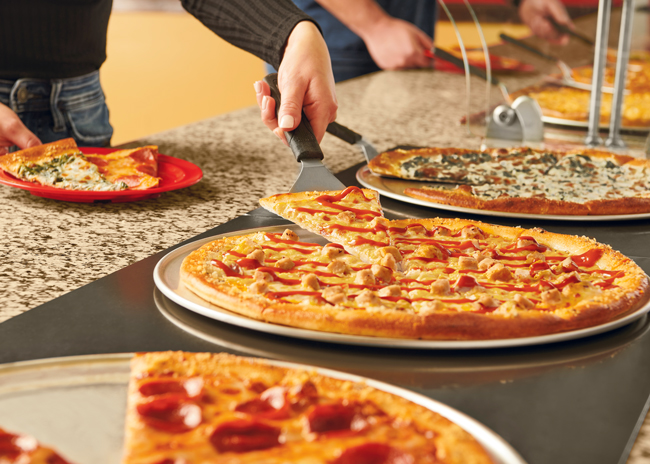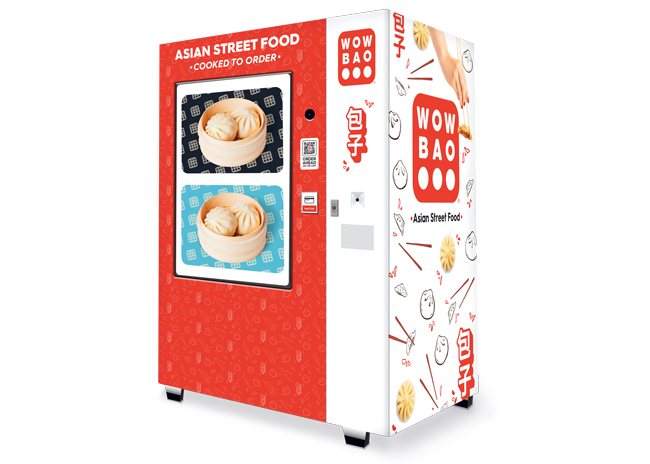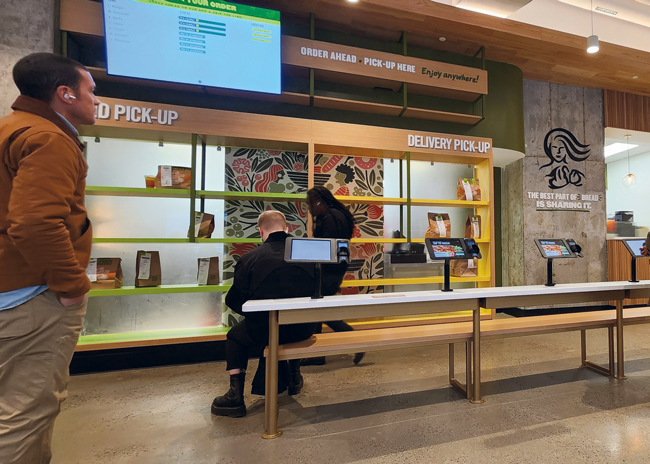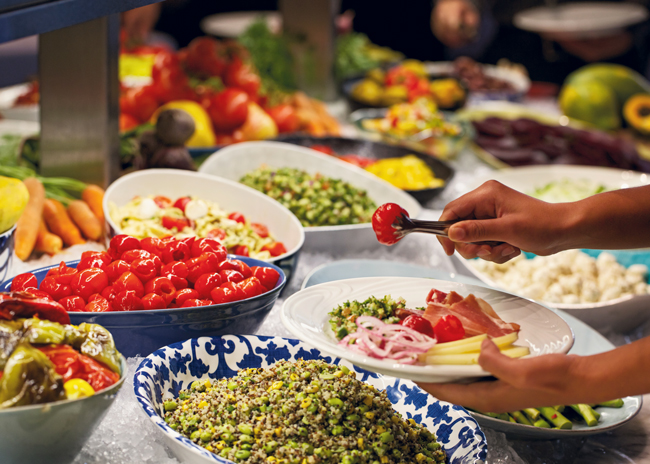High-tech solutions continue to surge as operators embrace digital ordering systems and no-seating formats. At the same time, traditional self-service food models — buffets — have reset, and legacy buffet operators are doubling down on that low-tech format.
Yes, it’s the foodservice industry, but it’s rapidly becoming much more about food than service in the traditional sense. Why? Because so much of the industry continues its pivot away from human-centric, high-touch service models and toward high-tech, digital-first business models that enable — even require — consumers to serve themselves. Like banks (ATMs), gas stations (pump your own/pay at the pump) and grocery retailers (self-checkout lanes), many foodservice operators embrace digital transformations and, in the process, push self-service into the mainstream.
 With new ownership, new branding strategies and inflation fueling demand for value, Cici’s Pizza looks toward a bright future for its unlimited self-serve buffet model. Photo courtesy of Cici’s PizzaCOVID-19, of course, accelerated the pace and scope of change. But the transformation was well underway before the pandemic shoved consumers en masse toward solutions such as self-order kiosks and mobile ordering. Such channels provided safer ports in the storm, yes, but they also were quickly embraced for being fast, accurate, highly customizable and infinitely more convenient ways to access meals prepared away from home.
With new ownership, new branding strategies and inflation fueling demand for value, Cici’s Pizza looks toward a bright future for its unlimited self-serve buffet model. Photo courtesy of Cici’s PizzaCOVID-19, of course, accelerated the pace and scope of change. But the transformation was well underway before the pandemic shoved consumers en masse toward solutions such as self-order kiosks and mobile ordering. Such channels provided safer ports in the storm, yes, but they also were quickly embraced for being fast, accurate, highly customizable and infinitely more convenient ways to access meals prepared away from home.
Rewarded with higher average orders, greater operational and labor efficiencies, and the ability to gather valuable consumer data, market leaders like McDonald’s, Yum! Brands and Panera Bread continue to invest, innovate and watch their digital sales grow. Consider:
- McDonald’s reports that in the second quarter of 2022, digital systemwide sales in its top six markets exceeded $6 billion, or nearly 33% of sales. This year’s second-quarter results showed digital systemwide sales in those same six markets had grown to more than $8 billion, or nearly 40% of total.
- In reporting its 2023 first-quarter results, Yum! Brands, parent of Taco Bell, KFC and Pizza Hut, noted “broad-based accelerating digital sales growth leading to a record quarter for both digital system sales of nearly $7 billion and digital sales mix that exceeded 45%.”
- Panera Bread now generates more than half of its total system sales via orders placed by customers digitally. In March, Panera upped its self-serve game, giving MyPanera loyalty club members the option of ordering by voice using Alexa. In May, it announced the launch of drive-thru pickup nationwide, and early last year, the brand debuted Panera To Go, a small, no-seats store format designed specifically to let customers quickly and easily pick up orders placed via digital channels.
Speed, Control and Convenience
Geoff Alexander, founder and CEO of Asian fast-casual brand Wow Bao, for which customer-facing digital solutions have long been a brand cornerstone, contends momentum behind self-service will only continue to grow. He sums up the state of self-service in the industry today as “bigger than it’s ever been — and smaller than it ever will be.”
Wow Bao implemented self-order kiosks in 2010 and fully automated front-of-the-house order pickup cubbies in 2017.
“We were one of the first, but self-service is now pretty much everywhere you go,” Alexander notes. “On the plus side, and the reason it will continue to grow, is that self-service gives those who want to use its speed, control and convenience. But there are minuses. First, it doesn’t always work. Second, the tipping aspect of it has gotten out of hand, making it uncomfortable for consumers. So, too, has the tendency to include so many prompts: Do you want to round up for charity? Will you do a survey? Do you want a bag? Anything else you want to add? By the time you’re done, they’ve asked 17 extra questions, and all you want to do is order, swipe your card and get moving.”
 Wow Bao’s newest self-serve initiative is hot food vending kiosks, which dispense its signature steamed bao buns piping hot and ready to eat in 32 seconds. Photo courtesy of Wow Bao
Wow Bao’s newest self-serve initiative is hot food vending kiosks, which dispense its signature steamed bao buns piping hot and ready to eat in 32 seconds. Photo courtesy of Wow Bao
From a broader perspective on the negative side, Alexander adds, offering self-service in a restaurant or retail setting too often equates to offering no service, and that’s a challenge that operators need to address as this form of service continues to grow. “This vehicle of how people can purchase products is definitely the future,” he says. “But businesses also have a responsibility to remove these types of negatives and friction points from the self-service experience or give guests the option of not using such options. Too many places are trading one for the other and assuming the consumer is OK with it.”
Rob Seeley, executive director, operations and strategy at WD Partners, a Columbus, Ohio-based strategy and design consultancy, also sounds notes of caution over on-site self-service options such as kiosks. From an operations standpoint, he says, what might seem a simple front-of-the-house solution can create back-of-the-house complexities in terms of order flow and kitchen capacity. There’s also the issue of maintenance, which makes smartphone-based mobile ordering increasingly attractive over kiosks for some operators, he suggests.
Furthermore, the assumption that every market is a good market in which to deploy self-service options can be risky. “Operators need to understand the customer base in individual markets,” Seeley says. “Some areas are more tech-savvy, and consumers there pretty much expect these options. Others are much less comfortable with them.”
And like Alexander, Seeley believes that removing human engagement, while successful for some brands in some segments, can carry significant risks for others. “For QSRs like McDonald’s or Taco Bell, it’s easy to get behind it. Speed, convenience and the ability to easily customize your order on your phone or on a kiosk fits the fast-food experience consumers have come to expect. But for others, the customer experience — including an element of human engagement — is a big brand differentiator,” he says. “Self-service has a lot of benefits, but when you lose human engagement, you lose a powerful differentiator. Operators need to think very carefully and strategically about what they’re trying to accomplish when integrating these types of technologies.”
Next-Gen Vending and Micromarkets
In Wow Bao’s case, the brand, menu and segment allow for continued development of innovative self-service options both inside and outside of its restaurant locations. Its newest initiative is automated hot-food vending kiosks, a segment the Food Marketing Institute expects to grow at a compound annual rate of 7.2% between 2022 and 2031. In partnership with a vending kiosk manufacturer, the company is launching fully branded Wow Bao-exclusive kiosks as well as offering select Wow Bow products in machines that feature multiple brands’ products.
“Our food comes out in 32 seconds, piping hot and ready to eat. And we can take these machines anywhere — airports, manufacturing plants, sports stadiums, hotels, movie theaters, college campuses, hospitals, you name it,” Alexander says. “They’re a self-serve option for fresh, hot, restaurant-quality food that’s available 24/7.”
Nahum Goldberg, principal at NG Associates, a San Francisco Bay Area-based consultancy with seven regional offices in North America, works extensively with clients in noncommercial foodservice segments. He, too, sees a lot of opportunity ahead for vending as a self-service solution. “Vending has been around for a long time,” he says, “but it’s becoming a very big deal as a self-service solution. With the newer machines, you can get anything from salads to pizza, burritos, burgers and smoothies, and the quality is generally very good.”
 Early last year, Panera Bread debuted Panera To Go, a compact, no-seats store format that lets customers quickly and easily pick up orders placed via kiosks or remote digital channels. Photo courtesy of Panera BreadAlso gaining momentum are micromarkets, many of which are now cashierless, fully self-serve operations, Goldberg adds. They often incorporate next-gen vending options as well as a variety of fresh and shelf-stable grab-and-go items and self-checkout or RFID technology that automatically charges customers for their selections. They’re a way, he says, for operators to save on labor and provide flexible food options, particularly in segments such as corporate dining, healthcare facilities and college campuses.
Early last year, Panera Bread debuted Panera To Go, a compact, no-seats store format that lets customers quickly and easily pick up orders placed via kiosks or remote digital channels. Photo courtesy of Panera BreadAlso gaining momentum are micromarkets, many of which are now cashierless, fully self-serve operations, Goldberg adds. They often incorporate next-gen vending options as well as a variety of fresh and shelf-stable grab-and-go items and self-checkout or RFID technology that automatically charges customers for their selections. They’re a way, he says, for operators to save on labor and provide flexible food options, particularly in segments such as corporate dining, healthcare facilities and college campuses.
The University of Toledo in Ohio is one such campus. The school’s dining program expanded a grab-and-go market location in its student union by adding two new vending kiosk options. One offers freshly blended dairy-free, gluten-free and vegan smoothies in less than one minute; the second offers White Castle sliders, molten lava cakes and other hot items. Both accept dining program dollars as well as credit and debit cards, according to Aaron Skees, director of marketing for the dining program.
Washington University in St. Louis is another example of where vending is a growing element of a portfolio of self-service options throughout campus. Mobile ordering or self-order kiosks now account for roughly 20% of the dining program’s volume, says Andrew Watling, director for dining services. “One of our newest dining halls has no traditional cashiers; it runs exclusively on kiosks and mobile orders,” he adds. “And in more of our coffee shops and other locations, we’re using kiosks. The students are very comfortable with them, and, from an operations standpoint, they help us to manage the overall volume flowing through the space without having a bunch of people standing in line.”
Watling agrees vending kiosks represent a big opportunity for campus dining programs. “There’s a lot of innovation in that segment, and that’s really where a lot of our efforts are going right now,” he notes. “Students want easy access to good food pretty much 24/7, but the reality is that we can’t staff for anywhere near that. It was tough to do before the pandemic and even tougher now. The technology has advanced to where we can offer foods that the students find fulfilling without us having to staff a location at 3 a.m.”
Washington University’s current vending kiosk program, introduced at the start of the 2022 school year, includes two machines that dispense fresh salads and three offering specialty coffee beverages. In addition, two of its retail market locations now offer RFID tag-enabled self-serve coolers stocked with grab-and-go foods. “We’re able to stock these unmanned options with high-quality, fresh products,” Watling says. “We can put vending machines into remote buildings or locations where there’s demand for foodservice but no budget to add a staffed cafe or other type of traditional venue. And they’re still representative of the type of food program that we want to offer.”
One year into the vending program, Watling says expansion is already in the works. “We’re hitting sales numbers from the machines that we never anticipated,” he says. “I found I was having to call the vendors every day asking for another restock. Like the other self-service options, the machines give students the speed, convenience and control they want and enable us to be smarter and more strategic about where and how we deploy our limited staff to make the biggest impact elsewhere.”
Low-Tech Buffets Rise Back Up in Traditional Self-Serve Models
Predicted to be unrevivable victims of pandemic-era closures, restrictions and safety concerns, it turns out serve-yourself food bars didn’t end up in the dustbin of the industry’s history after all. Yes, some salad bar and buffet brands did succumb in recent years, and not just because of the pandemic. Many operators also rejiggered former self-serve bars into employee-served elements. But with the height of the pandemic now passed and a tight labor market persisting, others are once again serving what for many guests is the ultimate fast, value-priced, something-for-everyone, entirely customizable, no-limits foodservice experience.
Buffet-segment leaders like Golden Corral and Cici’s Pizza report both sales and unit growth. And salad and hot food bar elements are once again offered in operations from grocery stores to dine-in restaurants, casinos and college campuses.
While it doesn’t offer all-you-care-to-eat buffets as its meal plan is retail-based, Washington University once again offers salad bars at select locations. “We do a lot of build-your-own that isn’t necessarily self-service in format, but we have brought back our self-serve salad bars, and we haven’t had any pushback from students,” Watling says. “We probably could have brought them back sooner. Yes, there are pockets of students who are still being a little more cautious, but the student body as a whole is largely back to business as usual.”
Location analytics firm Placer.ai, which has studied traffic at three buffet chains — Cici’s Pizza, Golden Corral and Pizza Ranch — noted in a recent blog post that buffets have significantly outperformed their comparable restaurant peers in full-service and fast-casual segments in terms of baseline visit growth since January 2021. “Notably, in 2022 when inflation began to dominate headlines, buffets’ baseline visit growth started to soar,” the company stated. “Likely, diners choosing to eat out became increasingly concerned for getting value for money, and buffets became a popular choice.”
“Everyone went away from self-serve food bars during COVID, but, while it depends on the organization, they do seem to be coming back,” notes Goldberg. “Salad bars in particular continue to be one of the most popular of self-service stations. People don’t want to give them up, even where made-to-order, fully customizable salads are available.”
That said, having experienced the restrictions on food bars during the pandemic, most of Goldberg’s clients returning to them are doing so with an eye toward protecting their operations for the future. “There’s a lot of interest in making sure a traditional salad bar, for instance, can easily convert to a made-for-you element — or in having a portion of a bar be self-service and a portion be served,” he says. “But the self-service salad bar isn’t going away. We’ve reviewed sales data recently, and it’s the most popular feature in a variety of client environments.”
Variety and Value
At Brazilian “rodizio”-style steakhouse chain Fogo de Chão, the Market Table is a centerpiece of the all-you-care-to-eat experience. An upscale salad bar on steroids, it offers a selection of fresh, roasted and pickled vegetables; prepared salads; charcuterie; cheeses; smoked salmon; seasonal soups; and a Feijoada section featuring Brazilian black bean and sausage stew with rice and traditional toppings. Included with all fixed-price meals, customers can also purchase the Market Table a la carte, and this offering is as popular as ever in the post-COVID environment, according to Barry McGowan, CEO.
“We have found that guests prefer to have control of their dining experiences,” McGowan notes. “Our young, dynamic guests love the customization that our dining experience offers. They can sit down and begin as soon as they’d like by visiting the Market Table or turning their coaster to green for our gaucho chefs to bring fire-roasted cuts of meat that are carved tableside.”
 Fogo de Chão’s self-serve salad bar, the Market Table, is as popular as ever and, along with its churrasco meats, remains a cornerstone of the brand’s all-you-care-to-eat experience. Photo courtesy of Fogo de ChãoFogo de Chão opened its 77th unit in late August in Providence, R.I., and McGowan says several additional units are on track to open in California, Texas and New Jersey by the end of the year. “We’ve experienced rapid growth across new and existing markets and are currently in our third year of 15% annual unit growth,” he says, adding that the brand continuously innovates, implementing new and seasonally inspired recipes to enhance the Market Table experience. This fall’s menu added selections “inclusive of all dietary tribes and preferences,” according to McGowan, including Beet Tartare, Harvest Black Rice Salad, and Roasted Butternut Squash and Apple Salad.
Fogo de Chão’s self-serve salad bar, the Market Table, is as popular as ever and, along with its churrasco meats, remains a cornerstone of the brand’s all-you-care-to-eat experience. Photo courtesy of Fogo de ChãoFogo de Chão opened its 77th unit in late August in Providence, R.I., and McGowan says several additional units are on track to open in California, Texas and New Jersey by the end of the year. “We’ve experienced rapid growth across new and existing markets and are currently in our third year of 15% annual unit growth,” he says, adding that the brand continuously innovates, implementing new and seasonally inspired recipes to enhance the Market Table experience. This fall’s menu added selections “inclusive of all dietary tribes and preferences,” according to McGowan, including Beet Tartare, Harvest Black Rice Salad, and Roasted Butternut Squash and Apple Salad.
Coppell, Texas-based buffet brand Cici’s Pizza is also back in growth mode after having declared bankruptcy in January 2021. Heavy losses due to the coronavirus proved the tipping point for the chain, which had been struggling and closing units for several years before the virus struck. Now, under new ownership (D&G Investors), the chain is growing again, according to Pamela Burisky, Cici’s director of quality, innovation and off-premises. Consumers, for the most part, are back to buffet usage as usual, she says, noting that the current inflationary environment makes the all-you-can-eat concept a popular choice. Now at just under 300 units, the company reported that systemwide sales grew by 31% last year over the prior year.
“Everything is pretty much back to normal. We do have guests who want special, made-for-you requests, which is something we’ve always offered, but the buffet is our big value proposition,” Burisky says. “You can’t go to any restaurant and get what you get from us at anywhere near our price point, which averages $8.49 per person. That includes a variety of pizzas, flatbreads, salads, soups, desserts, drinks. It’s a great assortment, all-you-can-eat, and everyone can get what they want.”
During the pandemic and coming out of bankruptcy, Burisky adds, Cici’s focused hard on operational efficiencies, reducing SKUs, doubling down on waste management strategies, and enhancing sanitation policies and procedures. While dine-in naturally dominates in buffet concepts, Cici’s continues to work to offer and build off-premises business as well.
Takeout and delivery at many units now comprise 25% to 30% of sales, according to Burisky. “We’ve come out of this stronger than ever,” she says. “Everyone thought buffets would be dead, but we’re thriving. We’re building LTOs and introducing new products. We’re back at franchising shows. We’ve launched new branding. We’ve rolled out a new prototype and digital marketing strategies. And consumers are responding.”
Seeley adds that as buffets regain their pre-pandemic popularity and try to attract new guests, the need for safety-enhancing, waste-reducing innovation in the category is great. In part, that means enhanced training, policies and procedures that help boost consumer confidence, he says, but it also means looking to high-tech solutions that improve operational efficiency.
“Some of our clients, for example, are testing new self-serve bar equipment that’s powered by artificial intelligence to monitor product quantities, temperatures and send signals to the kitchen when replenishment is needed,” Seeley says. “And more advanced predictive sales analytics are being used to help operators keep costs and waste down. As these types of smart, tech-based solutions continue to be developed and refined, we could see even more of a resurgence of salad bars and buffets.”




